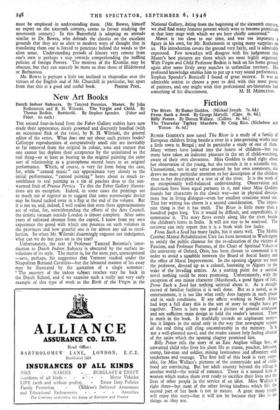New Art Books
Dutch Indoor Subjects. By Tancred Borenius. Manet By John Rothenstein and R. H. Wilenski. The Virgin and Child. By Thomas Bodkin. Botticelli. By Stephen Spender. (Faber and Faber. 6s. each.) - THE second four-in-hand from the Faber Gallery stables have now made their appearance, nicely groomed and discreetly handled (with an occasional flick of the reins), by R. H. Wilenski, the general editor of the series. What does one say about such picture books? Collotype reproductions of comparatively %mall size are inevitably so far removed from the original in colour, tone and texture that one cannot but deplore their acceptance by the uninitiated as the real thing—or at least as bearing. 'to the original painting the same sort of relationship as a gramophone record bears to an original performance. Which, of course, is very far from being the case, for, while "canned music" can 'approximate very closely to the initial performance, "canned painting" bears about as much re- semblance to real painting as a tin of peaches does to the sun- warmed fruit of Prunus Persica. To this the Faber Gallery illustra- tions are no exception. Indeed, in some cases the printings are so much out of register as to suggest that some stereoscopic device may be found tucked away in a flap at the end of the volume. But it is not so, and, indeed, I well realise that even these approximations are of value, for, notwithstanding the efforts of the Arts Council, the artistic vacuum outside London is almost complete. After some years of enforced absence from the capital, I know from my own experience the greed with which one pounces on such volumes in the provinces and how grateful one is for almost any aid to recol- lection. So when Mr. Wilenski disarmingly requests our indulgence, what can we do but pass on to the text?
Unfortunately, the text of Professor Tancred Borenius's intro- duction to Dutch Indoor Subjects is obscured by the surface in- volutions of its style. The matter is, for the most part, unexceptional —save, perhaps, his suggestion that Vermeer studied under the Neapolitan Bernard Cavallino—but the laboured manner of his essay may be illustrated by the quotation of a single sentence: "The ancestry of the indoor subject reaches very far back in the Dutch School, and if we examine such a really not very early example of this type of work as the Birth of the Virgin in the National Gallery, cliting from the beginning of the sixteenth century, we shall find many features present. which were to become prominent at that later stage with which we are here chiefly concerned."
Monet is too close to our time, and was too important a figure in his own, for Mr. Rothenstein to spring many surprises on us. His introduction covers the ground very fairly, and is admirably expressed. Few nowadays will disagree with his judgement that Manees best pictures are those which are most highly organised. With Virgin and Child Professor Bodkin is back on his home ground again after some lively away matches in unfamiliar territory. His profound knowledge enables him to put up a very sound performance. Stephen Spender's Botticelli I found of great interest. It was an admirable notion to choose a poet to deal with this most poetic of painters, and one might wish that professional art-historians had


























 Previous page
Previous page